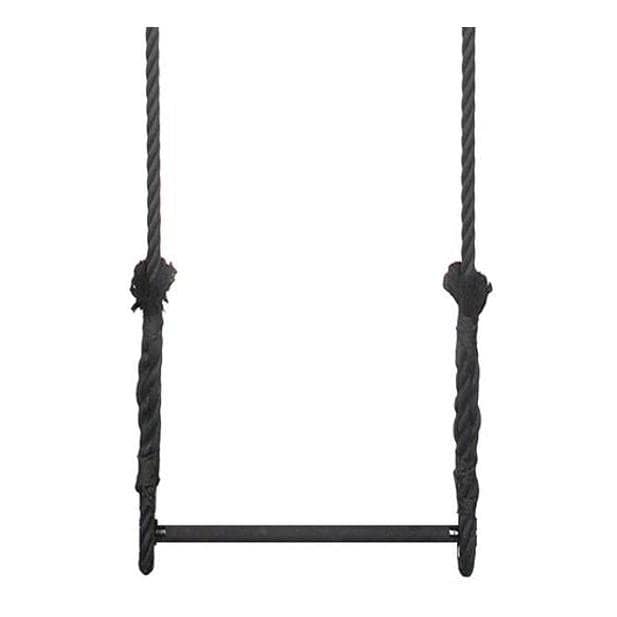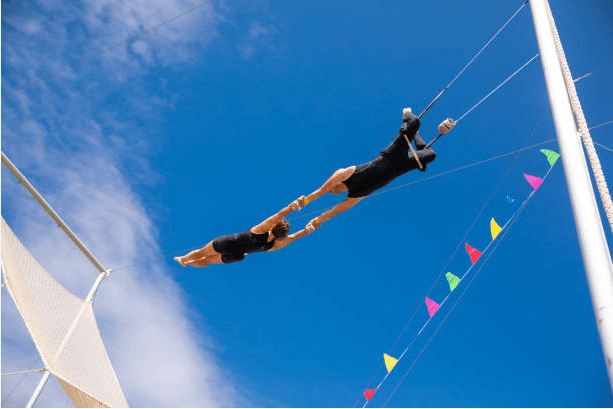In a world where athleticism and artistic expression converge, a daring and gravity-defying activity has captured the attention of enthusiasts and skeptics alike: the flying trapeze. With its fusion of acrobatics, daring feats, and breathtaking aerial displays, the flying trapeze embodies an intriguing blend of sport and artistry that prompts the question: Is Flying Trapeze a Sport? As we delve into the heart of this captivating endeavor, we uncover the intricacies that categorize flying trapeze as an extraordinary sport that thrives on precision, athleticism, and sheer courage.
Unraveling the Definitions: What Makes a Sport?
Before we leap into the exhilarating world of flying trapeze, let’s do a little terminology tightrope walk. What exactly defines a sport? Is it all about sweat, muscles, and endless rounds of competition, or can it encompass something as artistic and gravity-defying as flying trapeze?
Fact Check: According to the Cambridge Dictionary, a sport is defined as “all types of physical activity that people do to keep healthy or for enjoyment.” Meanwhile, the Oxford Dictionary takes a more competitive stance, stating that a sport is “an activity involving physical exertion and skill in which an individual or team competes against another or others for entertainment.”
Unveiling the Sporting Potential: Is Flying Trapeze a Sport?
In the case of flying trapeze, it’s a mesmerizing blend of physical prowess and artistic finesse. Performers gracefully glide through the air, executing complex maneuvers that require exceptional strength, flexibility, and timing. And let’s not forget the adrenaline rush that comes with soaring at heights that could make even a bird jealous.
Defining a Sport: Athleticism or Artistry?
At the crossroads of sport and spectacle, the flying trapeze exists as an exceptional discipline that challenges traditional notions of athleticism. Combining strength, agility, coordination, and mental fortitude, flying trapeze artists push the boundaries of human capabilities. While some may argue that its artistic nature dilutes its sportsmanship, the undeniable athleticism required to execute gravity-defying stunts cannot be overlooked.
So, where’s the bridge between art and sport? Well, flying trapeze isn’t just about executing tricks flawlessly – it’s about doing so with style, panache, and a touch of theatrical flair. From the graceful extension of a leg to the dramatic arch of the back during a mid-air twist, every move is a stroke of artistic genius. This union of athleticism and artistry is what makes the flying trapeze a unique spectacle that captivates both the sports enthusiast and the art connoisseur.
Athleticism in the Air: The Physique of a Trapeze Artist
Every swing, flip, and catch on the flying trapeze hinges on meticulous precision and impeccable technique. Athletes undergo rigorous training regimens to develop the muscle memory necessary for seamless transitions between movements. A mere miscalculation in timing or position could lead to perilous consequences, highlighting the intense discipline demanded by this aerial sport. If you’re curious about the roots of this exhilarating art form and how it has evolved over time, join us in uncovering the captivating journey in our article: ‘The Fascinating History of Trapeze: From Jules Leotard to Modern Acrobatics‘
Trapeze Types: Exploring the Diversity of Aerial Equipment
As we soar through the world of aerial acrobatics, it’s fascinating to witness the evolution of equipment that makes these breathtaking performances possible. From the heart-pounding stunts of flying trapeze to the intricate spins of the aerial silk, each apparatus adds its unique flair to the spectacle. If you’re curious to dive deeper into the various trapeze types and the diverse range of aerial equipment, we’ve got you covered. Discover more about the equipment that propels these artists to new heights in our article: Trapeze Types: Exploring the Diversity of Aerial Equipment.
In the realm of aerial artistry, the spotlight often shines on the heart-pounding performances of flying trapeze. However, the world of circus arts is as diverse as it is captivating, and that brings us to the static trapeze. While not as gravity-defying as its flying counterpart, the static trapeze offers its own mesmerizing allure. Artists gracefully weave their bodies around the bar, showcasing strength and flexibility that leave audiences in awe.

Exclusive Offer: Enjoy a 10% discount on all trapeze purchases for our valued readers. Use code ‘TRAPEZE10’ at checkout to claim your savings. Click on the image to buy
Artistry Aloft: The Dance of Aerial Acrobatics
Fluidity in Motion: The Artistic Dimension
Flying trapeze is not solely about mastering physical feats; it’s about creating a mesmerizing visual spectacle. The graceful arcs, twists, and spins executed mid-air are a testament to the artistry ingrained in this sport. The ability to transform raw athletic prowess into a visually captivating performance elevates flying trapeze beyond a mere physical challenge.
Expression and Emotion Aloft
As athletes soar through the air, their movements mirror a dance between strength and grace. Each swing tells a story, and each twist conveys emotion. This emotional engagement establishes a connection between performers and audiences, akin to the profound impact of any renowned sport. This blend of athleticism and emotional resonance cements the flying trapeze’s status as a unique sport-form hybrid.
Physical Benefits Beyond the Aerial Arena
Behind the Numbers: Physical Requirements
A study conducted by the International Journal of Sports Physiology and Performance found that flying trapeze athletes demonstrate remarkable muscular strength, agility, and cardiovascular endurance. The study concluded that their physical attributes align with those of elite athletes in traditional sports.
Benefits Beyond Classification
Whether flying trapeze officially joins the ranks of recognized sports or remains an artistic endeavor, its benefits are crystal clear. And no, we’re not just talking about the jaw-dropping stunts and eye-catching costumes!
- Physical Fitness: Flying trapeze is a full-body workout that targets muscles you never knew existed. The repeated swings, hangs, and catches build core strength, improve cardiovascular endurance, and enhance flexibility.
- Mental Agility: Remember, it’s not just about physical prowess. Flying trapeze demands mental focus and quick decision-making. A split-second delay or misjudgment could lead to a missed catch or an awkward landing.
- Confidence Boost: Conquering the fear of heights and mastering challenging tricks can do wonders for self-confidence. The feeling of accomplishment after nailing a difficult maneuver is akin to standing atop a metaphorical podium.
- Stress Relief: The sheer thrill of flying through the air can be an exhilarating stress-buster. The adrenaline rush releases endorphins, leaving you with a sense of euphoria that lasts long after you’ve touched solid ground.
Unveiling the Sport of the Skies: An Incontrovertible Verdict
Embracing the Dual Identity
Flying trapeze’s dual identity as both a sport and an art form underscores its exceptional nature. It embodies the essence of athleticism while captivating audiences with its artistic allure. Just as gymnastics marries grace with strength, so does flying trapeze blend artistry with sport.
FAQs: Flying Trapeze Unmasked
Before we sail through the clouds of judgment, let’s address some frequently asked questions that often catch people mid-flight.
Is flying trapeze only for daredevils?
Absolutely not! While it may seem like a daredevil’s playground, flying trapeze is accessible to people of various fitness levels. Many facilities offer classes tailored to beginners, focusing on building foundational skills in a controlled environment.
Can flying trapeze be dangerous?
Like any physical activity, there are risks involved. However, reputable flying trapeze schools prioritize safety. They provide thorough training, use high-quality equipment, and implement strict safety measures to minimize risks.
Do you need acrobatic experience to try flying trapeze?
Not at all. Flying trapeze welcomes enthusiasts from all walks of life. While a background in gymnastics or dance might offer a slight advantage, many beginners find their wings and progress quickly with proper instruction.
Is it a solo or a team activity?
Both! While individual performers showcase their skills, flying trapeze often involves teamwork during complex routines and catching maneuvers. It’s a perfect blend of individual excellence and collaborative artistry.
Is Flying Trapeze a Sport? Conclusion
As the curtain falls on our exploration of the skies, one question remains: Is Flying Trapeze a Sport? Amid the dizzying spins and daring flips, it’s clear that this aerial art form embraces both athleticism and creativity. So, whether you consider it a sport, an art, or a seamless fusion of both, there’s no denying the spellbinding allure of flying trapeze.
Fact Check: The artistic and athletic nature of flying trapeze continues to spark discussions about its classification. While it might not have gained full recognition as a sport in every corner of the world, its popularity and impact are undeniable.








